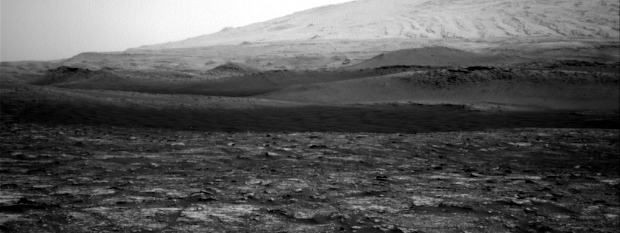
NASA's Mars rover Curiosity has spotted a dust devil swirling through the parched Red Planet landscape.
Curiosity photographed the dust devil on Aug. 9, capturing a spectral feature dancing along the border between dark and light slopes inside Mars' 96-mile-wide (154 kilometers) Gale Crater.
It's no surprise that these dry whirlwinds, which we also get here on Earth, are cropping up inside the crater these days, Curiosity team members said.
"It’s almost summer in Gale Crater, which puts us in a period of strong surface heating that lasts from early spring through mid-summer," Claire Newman, an atmospheric scientist at the Arizona-based company Aeolis Research, wrote in a mission update on Wednesday (Aug. 26). (Gale lies about 4.5 degrees south of the Martian equator.)
Related: Amazing Mars photos by NASA's Curiosity rover (latest images)
"Stronger surface heating tends to produce stronger convection and convective vortices, which consist of fast winds whipping around low pressure cores," Newman wrote. "If those vortices are strong enough, they can raise dust from the surface and become visible as 'dust devils' that we can image with our cameras."
Dust devils are typically quite faint, so Curiosity photos often must be processed before the features are visible, Newman added. But the Aug. 9 whirlwind showed up even in the raw, unprocessed rover imagery.
Get the Space.com Newsletter
Breaking space news, the latest updates on rocket launches, skywatching events and more!
Curiosity's recent activities have included study of such dust devils, using the rover's cameras and its onboard weather station, Newman wrote. But the $2.5 billion mission's main science work focuses on the analysis of Martian rock and soil to learn more about the planet's climate evolution and its past ability to support life.
Shortly after landing inside Gale Crater in August 2012, Curiosity's observations allowed scientists to determine that, billions of years ago, the area hosted a potentially habitable lake-and-stream system. In September 2014, the car-size robot reached the base of Mount Sharp, which rises 3.4 miles (5.5 kilometers) into the Martian sky from Gale's center. Ever since then, Curiosity has been climbing through the mountain's foothills, reading the many rock layers for clues about how the Red Planet changed over time.
Curiosity has spotted dust devils on Mars before, and so have the rover's robotic cousins. NASA's Opportunity and Spirit rovers photographed the features, for example, and the agency's Mars Reconnaissance Orbiter has given us birds-eye views of the alien twisters.
Mike Wall is the author of "Out There" (Grand Central Publishing, 2018; illustrated by Karl Tate), a book about the search for alien life. Follow him on Twitter @michaeldwall. Follow us on Twitter @Spacedotcom or Facebook.
Join our Space Forums to keep talking space on the latest missions, night sky and more! And if you have a news tip, correction or comment, let us know at: community@space.com.

Michael Wall is a Senior Space Writer with Space.com and joined the team in 2010. He primarily covers exoplanets, spaceflight and military space, but has been known to dabble in the space art beat. His book about the search for alien life, "Out There," was published on Nov. 13, 2018. Before becoming a science writer, Michael worked as a herpetologist and wildlife biologist. He has a Ph.D. in evolutionary biology from the University of Sydney, Australia, a bachelor's degree from the University of Arizona, and a graduate certificate in science writing from the University of California, Santa Cruz. To find out what his latest project is, you can follow Michael on Twitter.









